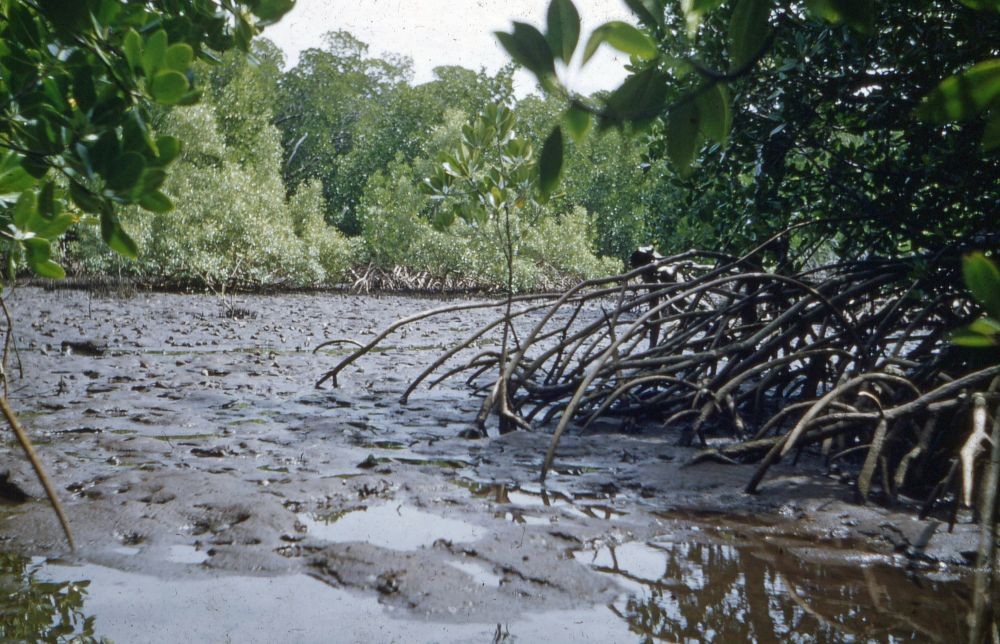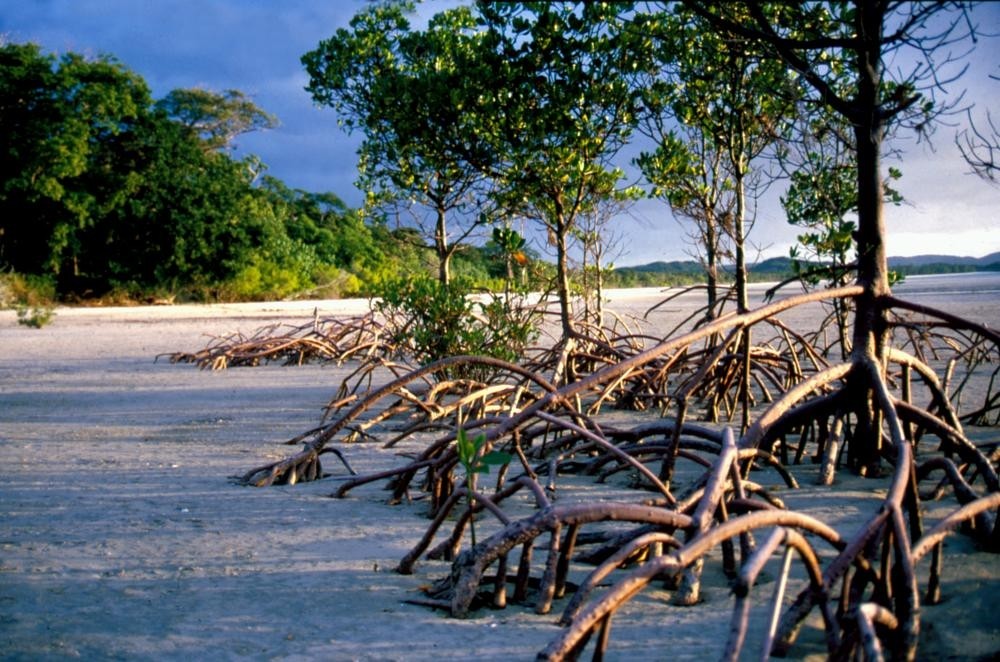Queensland’s coastal kidneys: mangroves
By Stacey Larner, Librarian, Queensland Memory & Joan Bruce, Specialist Librarian, Queensland Memory | 9 August 2021
Much of Australia’s flora has been isolated since the break-up of Gondwana, but hugging our northern coastlines are another class of plants. They seem to look outwards towards the Pacific and Asia, rather than inwards to a continent isolated since the time of the dinosaurs. Coastal First Nations people used them in multiple ways; for food and decoration and as a source of wood. The leaves of the Barringtonia species were used to poison fish.

Charlie Walker hunting stingrays amongst the mangroves. Darren Clark Wujal Wujal Photographs, image number 30201-0006-0016, John Oxley Library, State Library of Queensland.
Francis Ratcliffe, writing in the Telegraph (Brisbane), 7 June 1938, left no doubts about his feelings for the mangrove when he wrote:
mangroves - there is some excuse for the disgust they inspire in most people. They are indecent-looking vegetables, the hobgobblins [sic] and abortions of the arboreal world.

Mangrove roots in the mud at low tide on Low Island, Queensland, 1954. 30832 Report on Scientific Expedition to Low Isles in 1954, John Bristow, image number 30832-0001-0013, John Oxley Library, State Library of Queensland.
Ratcliffe’s entertaining turn of phrase warrants an extra quote:
The imaginative layman, however, might be pardoned for thinking that the tidal ooze - scorned by all decent trees as a dwelling-place - had become a refuge for the products of some of the Creator's more fanciful experiments. Here, huddled together in their shame, they can live in peace, harbouring in their shade swarms of mosquitoes and sandflies to mount guard over their privacy.
As I say, the mangroves are monsters among shrubs.

Mangroves growing on the beach, North Queensland, 1984. 7435 Ron and Ngaire Gale Collection, Image number 407-38-03, John Oxley Library, State Library of Queensland.
He was certainly not alone in his thinking. Under the guise of “improvements”, mangroves were cleared from coasts at a rapid pace by the developing towns around Queensland. The communities of Green Island, Wellington Point, Cairns and the Gold Coast proclaim their improvement work in the first half of the twentieth century, betraying a dislike of mangroves.

Orange mangrove – Margaret Lawrie Collection of Torres Strait Islands Material. Watercolour, 24 Apr 1972. TR 1791/215 Margaret Lawrie Collection of Torres Strait Islands Material 1964-1998, Margaret Elizabeth Lawrie 1917-2003.
Eventually the Queensland Government realised the tremendous importance of mangroves. 44% of Australia’s mangroves occur in Queensland, and the fishing industry relies on mangrove forests as breeding and nursery grounds for fish species. They provide protection against storm surges and erosion, filter catchment runoff and store carbon. The 1994 Fisheries Act protects mangroves and all marine plants.

RBQ 910.41 Barringtonia from Johann Reinhold Forster's Reise um die Welt wahrend den Jahren 1772 bis 1775 in dem von Seiner Iztregierenden Grossbrittannischen Majestat auf Entdekungen ausgeschickten und durch den Captain Cook gefuhrten Schiffe the Resolution unternommen by Georg Forster.
The January 2011 floods had a significant impact on Brisbane’s mangrove population. The grey mangrove (Avicennia marina) is Australia’s most common mangrove, and is one of the main species that lines the Brisbane River, along with the river mangrove (Aegiceras corniculatum—seen below) and milky mangrove (Excoecaria agallocha).

River mangrove from Botanical miscellany vol. 5. RBJ 581 HOO Botanical miscellany : containing figures and descriptions of such plants as recommended themselves by their novelty, rarity, or history, or by the uses to which they are applied in the arts, in medicine, and in domestic economy [sic] / by William Jackson Hooker.
Mangroves are featured in both the Entwined: plants and people exhibition and Kindred Spirits: plants and people publication. Kindred Spirits: plants and people is available to purchase from the Library Book Shop. With text by Shannon Brett, featuring images from State Library’s collection and more, it explores the ancient and ongoing connection between First Nations people and plants in Queensland. This publication was developed in response to the Entwined: plants and people exhibition which is open now and runs until November 14, 2021.
Other blogs relating to Entwined: plants and people
- Bountiful bunyas : a charismatic tree with a fascinating history
- Queensland's fern fever
- Orchidelirium: when love turns to obsession
- Keeping culture alive through weaving
- Xanthorrhoeas - An Australian Explosive
- The grand florilegiums of Joseph Banks and Ferdinand Bauer
- Grand botanical publications of the 18th and 19th centuries: from scientific discovery to practical horticulture
Comments
Your email address will not be published.
We welcome relevant, respectful comments.